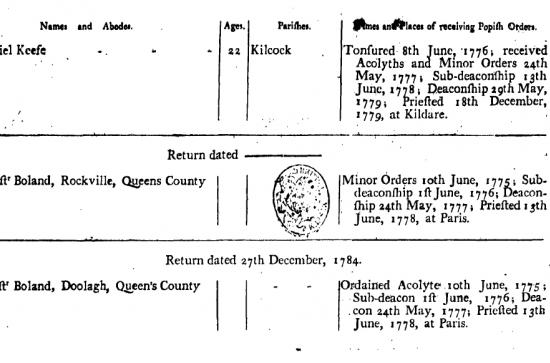
Dr Richard Fitzpatrick has recently completed a six-week work package as part of the Clericus prosographical research project. Focusing on Ireland’s Catholic clergy at home and abroad during the eighteenth century, his research compiled several thousand individual records for future ingestion into the database. Part of his work also involved identifying multifaceted content delivery, including the visualisation of data via mapping, graphs and charts for educational purposes and further research.
A total of 73 collections and approximately 21,763 un-disambiguated biographical records were identified for future ingestion into the system. The majority of the collections identified were located on JSTOR, with the most useful data found within separate issues of Archivium Hibernicum, and to a lesser extent Collectanea Hibernica. Several diocesan histories were also located and checked. In general, these antiquarian collections contain a lot of data that may not have survived to the present day in their original form. However, given their formatting and structuring (or lack thereof), these histories represented the most difficult/time consuming collections to examine for information concerning Irish clerics.
The compiling of the prosographical database will permit multifaceted content delivery, including the visualisation of data via mapping, graphs and charts for educational purposes and further research. The most complete collections for Ireland’s eighteenth-century Catholic clergy are governmental lists compiled in 1704 and 1731. Both of these collections are not without their limitations, but the former collection is particularly suited to mapping the number and distribution of Ireland’s Catholic clergy (and their lay supporters) at the beginning of the penal era. Although the coverage and data from the 1731 report on popery is less complete, the information it contains concerning the number of clerics, churches and schoolhouses is also very suitable to mapping. In essence, the compiling and mapping of the data for both periods will provide a very useful and visually striking representation of the Catholic Church during the height of the penal era; a representation that challenges traditional/popular depictions of this period. In turn, this data and mini-project can act as the foundation for the future expansion of the database back into earlier centuries and forward into the nineteenth century.
A future work package will broaden the project’s focus by including data on Church of Ireland clerics. Fortunately, several manuscript collection lists have been previously compiled and are held in Irish church and state archives. As with the previous work package, the collection of this data will begin with the eighteenth century and then expand out to encompass the preceding and following centuries.
By the project’s end, it is planned to have compiled a database on all known Irish clergy, with a standardised entry system that will include information such as the name of the cleric, his diocese, parish(es), education, date and place of ordination, ordaining bishop and date of birth and death.
